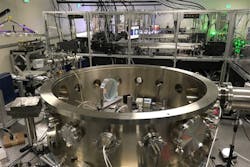Laser-heated nanowires produce microscale nuclear fusion with record efficiency
Using a compact "homebuilt" ultrafast laser to heat arrays of ordered nanowires, scientists at Colorado State University (CSU; Fort Collins, CO) and collaborators have demonstrated microscale nuclear fusion in the lab. They have achieved record-setting efficiency for the generation of neutrons (which result from the fusion process).1
Laser-driven controlled fusion experiments are typically done via inertial confinement, for example at the the National Ignition Facility (NIF; Livermore, CA), requiring multi-hundred-million-dollar, multikilojoule lasers. Such experiments are geared either toward harnessing nuclear fusion for clean energy applications, or to materials studies.
In contrast, the CSU-led team of students, research scientists, and collaborators work with an ultrafast tabletop laser producing pulses with 60 fs duration, energies up to 1.65 J, and a center wavelength of 400 nm, with the laser light focused with an f/1.7 parabolic mirror. The target is an array of 200- or 400-nm-diameter deuterated polyethylene (CD2) nanowires.
The short pulses couple very well to the volume deep within the nanowire array, turning a several-micron-deep layer of the CD2 into plasma and leading to deuteron-deuteron (D-D) fusion.
Record fusion-neutron yield for joule-level laser pulses
"The maximum number of neutrons per shot was measured to be 3.6 × 106 for a laser pulse energy of 1.64 J, corresponding to 2.2 × 106 neutrons per joule, the largest fusion neutron yield obtained to date for joule-level laser pulse energies," the authors of the Nature Communications paper note. This yield is about 500 times higher than experiments that use conventional flat targets from the same material.
The efforts were supported by intensive computer simulations conducted at the University of Dusseldorf (Germany), and at CSU.
Making fusion neutrons efficiently, at a small scale, could lead to advances in neutron-based imaging, and neutron probes to gain insight on the structure and properties of materials. The results also contribute to understanding interactions of ultra-intense laser light with matter.
Source: https://engr.source.colostate.edu/in-csu-lab-laser-heated-nanowires-produce-micro-scale-nuclear-fusion-with-record-efficiency/
REFERENCE:
1. Alden Curtis et al., "Micro-scale fusion in dense relativistic nanowire array plasmas," Nature Communications (2018); doi: 10.1038/s41467-018-03445-z (open paper)

John Wallace | Senior Technical Editor (1998-2022)
John Wallace was with Laser Focus World for nearly 25 years, retiring in late June 2022. He obtained a bachelor's degree in mechanical engineering and physics at Rutgers University and a master's in optical engineering at the University of Rochester. Before becoming an editor, John worked as an engineer at RCA, Exxon, Eastman Kodak, and GCA Corporation.
